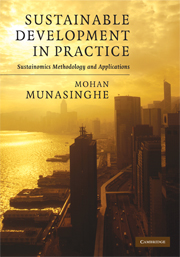Book contents
- Frontmatter
- Contents
- Foreword by James Gustave Speth
- Preface
- Part I Framework and fundamentals
- Part II Global and transnational applications
- Part III National and macroeconomic applications
- 7 National economy-wide applications
- 8 Mathematical macromodel applications
- 9 Computable general equilibrium modelling applications
- Part IV Sub-national sectoral and system applications
- Part V Project and local applications
- References
- Index
9 - Computable general equilibrium modelling applications
Published online by Cambridge University Press: 05 August 2012
- Frontmatter
- Contents
- Foreword by James Gustave Speth
- Preface
- Part I Framework and fundamentals
- Part II Global and transnational applications
- Part III National and macroeconomic applications
- 7 National economy-wide applications
- 8 Mathematical macromodel applications
- 9 Computable general equilibrium modelling applications
- Part IV Sub-national sectoral and system applications
- Part V Project and local applications
- References
- Index
Summary
In this chapter, two case studies demonstrate the use of computable general equilibrium (CGE) models to analyse economy-wide sustainable development issues and explore economic–social–environmental links. Sections 9.1 to 9.4 develop the ECOGEM model to assess economic, social and environmental policy linkages in Chile – focusing on urban air pollution, poverty, income distribution and employment. The model examines the potential for combining different policies to enhance positive cross-effects of environmental and social policies, or to mitigate the negative side-effects of any single policy. The results show that general equilibrium modelling is useful for holistically analysing the impacts of different economy-wide policies. Winners and losers may be identified with the potential magnitude of gains and losses, including indirect effects. In Sections 9.5 to 9.7, a static CGE model of Costa Rica is used to study the effects of macroeconomic policies on deforestation and to identify remedial policy options. The model confirms the results of partial equilibrium analyses: (1) establishing property rights tends to decrease deforestation, because such rights allow forest users to capture the future benefits of reduced logging damage today and (2) higher interest rates promote deforestation and vice versa. The CGE approach also clearly identifies the indirect effects (due to intersectoral links), which must be combined with the direct effects to determine the total impact. Finally, the model underlines the importance of pursuing sectoral reforms in the context of growth. A dynamic CGE model of Costa Rica gives essentially the same results as the static CGE model presented here.
- Type
- Chapter
- Information
- Sustainable Development in PracticeSustainomics Methodology and Applications, pp. 269 - 310Publisher: Cambridge University PressPrint publication year: 2009



